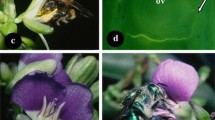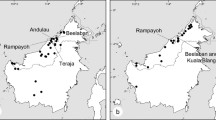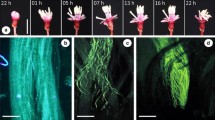Abstract
Polygala vauthieri andP. monticola var.brizoides have secondary pollen presentation from a basket-like structure on the style apex. This basket is loaded after the first visit by a bee. Pollen reception, therefore, can precede the issue of pollen. A sticky stigma secretion glues the pollen from the basket under the head of the bee visitor in an exactly predetermined spot on the left side only. This position mostly forms a kind of safe spot, where the bee can not remove the pollen. The exact position on the bee's head is determined by the species specific distance between style tip and nectary in the visited flower. In this way the two sympatric species deposit the pollen 2 mm apart on the visitor and so can avoid hybridization pollination, while being visited by the same group of bees.
Similar content being viewed by others
Literature Cited
Brantjes, N. B. M., van der Pijl, L., 1980: Pollination mechanisms in Polygalaceae. — Acta Bot. Neerl.29, 56–57.
Ducke, A., 1901: Beobachtungen über Blütenbesuch, Erscheinungszeit etc. der bei Pará vorkommenden Bienen. — Z. Syst. Hymen. u. Dipter.1, 25–32, 49–67.
Ducke, A., 1902: Beobachtungen über Blütenbesuch, Erscheinungszeit, etc. der bei Pará vorkommenden Bienen. — Allg. Z. Entomol.18, 321–326, 360–368, 400–405, 417–422.
Faegri, K., van der Pijl, L., 1979: The Principles of Pollination Ecology. 3d. ed. — Oxford: Pergamon Press.
Goebel, K., 1923: Organographie der Pflanzen, insbesondere der Archegoniaten und Samenpflanzen. Teil III, Heft II. — 2nd ed. — Jena: Gustav Fischer Verlag.
—, 1933: Organographie der Pflanzen, insbesondere der Archegoniaten und Samenpflanzen. Teil III. 3rd ed. — Jena: Gustav Fischer Verlag.
Hildebrand, F., 1867: Frederigo Delpino's Beobachtungen über die Bestäubungsvorrichtungen bei den Phanerogamen. Mit Zusätzen und Illustrationen. — Bot. Z.25, 266–270, 274–278, 282–287.
Kennedy, H., 1978: Systematics and pollination of the “closed-flowered” species ofCalathea (Maranthaceae). — Univ. Calif. Publ. Bot.71.
Knuth, P., Loew, E., 1904, 1905: Handbuch der Blütenbiologie III, Die bisher in außereuropäischen Gebieten gemachten blütenbiologischen Beobachtungen. — Leipzig: Wilhelm Engelmann Verlag.
MacLeod, J., 1891: De Pyreneenbloemen en hare bevruchting door insecten, eene bijdrage tot de bloemengeographie. — Bot. Jaarb., Gent,3, 260–485.
Müller, H., 1873: Die Befruchtung der Blumen durch Insecten und die gegenseitigen Anpassungen beider, Ein Beitrag zur Kenntnis des ursächlichen Zusammenhanges in der organischen Natur. — Leipzig.
Pijl, L. van der, 1978: Reproductive integration and sexual disharmony in floral functions. — In:Richards, A. J., (Ed.): The Pollination of Flowers by Insects, 79–88. — London: Acad. Press.
Schoenichen, W., 1922: Mikroskopisches Prakticum der Blütenbiologie. — Leipzig: Quelle & Meyer Verlag.
Scott-Elliot, G. F., 1891: Notes on the fertilisation of South African and Madagascar flowering plants. — Ann. Bot.5, 333–405.
Vogel, S., 1954: Blütenbiologische Typen als Elemente der Sippengliederung, dargestellt an Hand der Flora Südafrikas. — Botan. Stud.1. — Jena: G. Fischer.
Author information
Authors and Affiliations
Rights and permissions
About this article
Cite this article
Brantjes, N.B.M. Pollen placement and reproductive isolation between two brazilianPolygala species (Polygalaceae). Pl Syst Evol 141, 41–52 (1982). https://doi.org/10.1007/BF01006478
Received:
Issue Date:
DOI: https://doi.org/10.1007/BF01006478




